
JOURNAL OF CULTURAL HERITAGE
Scope & Guideline
Cultivating Understanding of Our Cultural Roots.
Introduction
Aims and Scopes
- Interdisciplinary Research:
The journal emphasizes research that integrates various scientific disciplines such as chemistry, physics, biology, and engineering to address issues related to cultural heritage preservation. - Technological Innovations:
There is a strong focus on innovative technologies and methodologies, including non-invasive imaging, machine learning, and advanced materials, aimed at improving conservation techniques and understanding heritage degradation. - Cultural Heritage Management:
The journal explores the socioeconomic aspects of cultural heritage, including risk assessment, community engagement, and the impact of climate change on heritage sites. - Material Science Applications:
Research on the properties and behaviors of materials used in cultural heritage, including their degradation mechanisms and methods for their conservation, is a core area. - Case Studies and Practical Applications:
The journal features numerous case studies that document practical applications of research findings in real-world scenarios, showcasing successful conservation projects and methodologies. - Intangible Cultural Heritage:
In addition to physical artifacts, there is also a focus on the preservation of intangible cultural heritage, including practices, traditions, and oral histories.
Trending and Emerging
- Digital Heritage and Virtual Reality:
There is a growing trend in utilizing digital technologies, including virtual reality and augmented reality, for the documentation, preservation, and visualization of cultural heritage. - Machine Learning and Artificial Intelligence:
The integration of machine learning and AI in analyzing and preserving cultural heritage artifacts is increasingly prominent, showcasing the potential for automated analysis and predictive modeling. - Sustainable Conservation Practices:
Research focusing on eco-friendly materials and sustainable practices for the conservation of cultural heritage is on the rise, reflecting a broader concern for environmental impact. - Advanced Imaging Techniques:
Emerging imaging techniques, such as hyperspectral imaging and 3D scanning, are gaining traction for their ability to provide detailed analyses of artifacts without damaging them. - Cultural Heritage in the Context of Climate Change:
There is an increasing emphasis on understanding the effects of climate change on cultural heritage, including risk assessment and adaptation strategies. - Community Engagement and Public Participation:
Research exploring the role of community involvement in cultural heritage preservation efforts is becoming more prevalent, highlighting the importance of local knowledge and participation.
Declining or Waning
- Traditional Restoration Techniques:
There seems to be a waning interest in conventional restoration methods that do not incorporate modern scientific approaches, as the field increasingly adopts innovative technologies. - Generalized Conservation Strategies:
The journal appears to be moving away from broad, generalized strategies for conservation in favor of more specialized, evidence-based approaches tailored to specific materials and contexts. - Historical Documentation Methods:
Research focusing solely on historical documentation methods without integrating new technologies or interdisciplinary approaches is becoming less prevalent. - Single-Discipline Studies:
There is a noticeable decline in studies that focus on a single discipline without interdisciplinary collaboration, as the journal increasingly promotes comprehensive, multi-faceted research. - Theoretical Frameworks Without Practical Application:
Papers that present purely theoretical frameworks without practical applications or case studies are becoming less common, reflecting a shift towards more applicable research.
Similar Journals
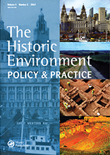
Historic Environment-Policy & Practice
Pioneering Sustainable Practices in Historic Environments.Historic Environment-Policy & Practice is an esteemed journal that serves as a vital platform for interdisciplinary discourse within the fields of archaeology, conservation, and history. Published by Routledge Journals, Taylor & Francis Ltd, this journal enjoys notable recognition, characterized by its Q1 rankings in 2023 across all relevant categories. This esteemed status positions it among the top tier of publications, with Scopus rankings reflecting its impact, such as a remarkable 98th percentile in Arts and Humanities - History. Aimed at researchers, professionals, and students, the journal publishes insightful articles that connect policy with practical applications in the historic environment. With its dedicated focus on promoting the understanding and sustainability of cultural heritage, Historic Environment-Policy & Practice is a crucial resource for anyone involved in the preservation and study of our collective past. No open access is available, but the journal ensures high-quality peer-reviewed content showcasing the latest research and practices in the field.

RESTAURATOR-INTERNATIONAL JOURNAL FOR THE PRESERVATION OF LIBRARY AND ARCHIVAL MATERIAL
Advancing Conservation, One Article at a Time.RESTAURATOR-INTERNATIONAL JOURNAL FOR THE PRESERVATION OF LIBRARY AND ARCHIVAL MATERIAL, published by WALTER DE GRUYTER GMBH in Germany, is an esteemed scholarly journal dedicated to the conservation and preservation of library and archival materials. With a history spanning from its first publication in 1970, this journal has become a vital resource for professionals, researchers, and students in the fields of conservation, materials science, and media technology. The journal holds a Q2 classification in Conservation and positions itself within the top 30% of its peer category, reflecting its commitment to quality research and innovative practices. Although the journal is not open access, it offers invaluable insights into preservation methodologies, case studies, and advances in materials technology, supporting the ongoing dialogue within the conservation community. Its indexed presence in Scopus, especially notable in the Arts and Humanities and Engineering categories, further underscores its relevance and impact in shaping contemporary practices in conservation.
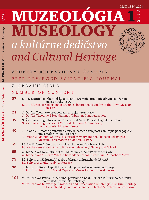
Muzeologia a Kulturne Dedicstvo-Museology and Cultural Heritage
Innovating practices in preserving our cultural legacy.Muzeologia a Kulturne Dedicstvo-Museology and Cultural Heritage is a premier scholarly journal published by COMENIUS UNIVERSITY BRATISLAVA, focusing on the vital intersections of museology, cultural heritage, and conservation practices. Since its inception in 2013, this open-access journal has established itself as a leading platform for high-quality research, boasting impressive rankings in the 2023 Scopus metrics—#15 out of 83 in Museology and #28 out of 103 in Conservation. With a commitment to fostering an inclusive academic community, the journal welcomes innovative studies and critical discussions that address contemporary challenges in preserving cultural assets. Operating under an open-access model since 2017, Muzeologia a Kulturne Dedicstvo ensures wide dissemination of research findings, thereby enhancing visibility and accessibility for scholars, professionals, and students worldwide. As it continues to converge from 2013 to 2024, this journal not only serves as a vital resource but also as a catalyst for advances in the understanding and practice of museology and cultural heritage preservation.
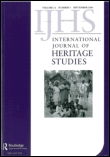
International Journal of Heritage Studies
Exploring the rich tapestry of cultural heritage.Welcome to the International Journal of Heritage Studies, a prestigious publication dedicated to advancing knowledge in the fields of heritage conservation, cultural studies, and museology. Published by Routledge Journals, Taylor & Francis Ltd in the United Kingdom, this journal boasts an impressive impact ranking, positioned in the Q1 category for multiple disciplines, including Conservation and Cultural Studies, and a remarkable HIndex indicative of its influence within academia. With a history spanning from 1994 and continuing to 2024, the journal serves as an essential platform for researchers, professionals, and students aiming to contribute to the dynamic discourse surrounding heritage preservation and cultural management. Although the journal does not offer open access, it remains a vital resource for those interested in the nuanced intersections of heritage and society, as evidenced by its high ranks in various academic categories. The International Journal of Heritage Studies is committed to fostering innovative research and critical analysis in its field, inviting submissions that explore diverse methodologies and theoretical perspectives.
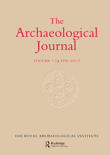
Archaeological Journal
Fostering Dialogue, Enriching Archaeological StudiesArchaeological Journal, published by Taylor & Francis Ltd, stands as a leading voice in the field of archaeology, with a remarkable distinction in the Q1 category for both arts and humanities as well as conservation, underscoring its critical role in advancing scholarly dialogue and research. With an ISSN of 0066-5983 and E-ISSN of 2373-2288, this journal provides a platform for innovative research from 1977, now offering insights up to 2024. The United Kingdom-based journal is highly regarded, being within the top 81st percentile in archaeology and conservation according to Scopus rankings. Essential for researchers, professionals, and students, the journal's content spans rigorous archaeological studies, theoretical advancements, and discussions on conservation practices, ultimately aimed at fostering a deeper understanding of humanity's past. Notably, with no open access option, it maintains a traditional publishing approach, thereby ensuring curated and high-quality contributions to the academic community.

MUSEOLOGIA SCIENTIFICA
Exploring Innovative Practices in Science MuseumsMUSEOLOGIA SCIENTIFICA is a distinguished journal dedicated to the study and advancement of museology, published by the ASSOCIAZIONE NAZIONALE MUSEI SCIENTIFICI in Italy. Focusing on a wide array of topics within the realm of science museums, the journal offers rich insights and research findings that shape the future of museum practices and education. Although currently not an open-access publication, MUSEOLOGIA SCIENTIFICA provides a vital platform for scholars, practitioners, and students interested in the preservation, curation, and display of scientific artifacts. By contributing to the discourse on innovative museum practices, the journal plays a crucial role in enhancing the professional standards within the field while promoting collaboration among museums worldwide. We invite researchers and practitioners alike to explore its valuable content, aimed at broadening understanding and knowledge in the ever-evolving landscape of museology.
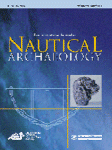
INTERNATIONAL JOURNAL OF NAUTICAL ARCHAEOLOGY
Diving into the Rich Tapestry of Maritime CulturesWelcome to the International Journal of Nautical Archaeology, a premier peer-reviewed publication dedicated to advancing the study of maritime history and underwater archaeology. Published by Taylor & Francis Ltd, this esteemed journal, indexed with an ISSN of 1057-2414 and an E-ISSN of 1095-9270, serves as a vital platform for researchers, professionals, and students alike. Celebrated for its rigorous scholarship, the journal ranks in the top quartile for both Archaeology and History in 2023, reflecting its influential role within the academic community. Covering a broad spectrum of topics from ancient shipwrecks to contemporary marine archaeology practices, the journal aims to foster interdisciplinary dialogues that enrich our understanding of humanity's maritime heritage. With a publication history dating back to 1972, it continues to thrive as a key resource in the field. Although currently not offering Open Access, the insights published in this journal are invaluable for those seeking to explore the intersections of archaeology and oceanography, making it a must-read for anyone engaged in or studying these dynamic disciplines.
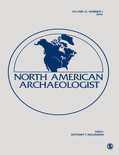
NORTH AMERICAN ARCHAEOLOGIST
Elevating Archaeological Discourse in North AmericaNORTH AMERICAN ARCHAEOLOGIST, published by SAGE PUBLICATIONS INC, is a prestigious journal that serves as an essential resource for professionals and scholars in the field of archaeology. With its ISSN 0197-6931 and E-ISSN 1541-3543, the journal aims to disseminate high-quality research that contributes to the understanding of the historical and cultural significance of North America from prehistory to the present. As of 2023, it holds an impressive Q2 category in Archaeology and ranks within the Q1 tier for Archaeology (arts and humanities), positioning it among the top journals in its field. Its Scopus rankings further emphasize its significance, reflecting a commendable percentile standing that underscores its influence in both arts and humanities and social sciences. The journal is committed to offering a platform for innovative research and scholarly discussion, making it invaluable for researchers, professionals, and students dedicated to advancing archaeological knowledge.

Egyptian Journal of Archaeological and Restoration Studies
Bridging Disciplines in Archaeology and Conservation.Welcome to the Egyptian Journal of Archaeological and Restoration Studies, a vital resource for scholars and practitioners in the field of archaeology and restoration. Published by the renowned SOHAG UNIV PUBLICATION CENTER-SUPC, this journal aims to disseminate cutting-edge research that illuminates the rich archaeological heritage of Egypt and beyond. With ISSN 2090-4932 and E-ISSN 2090-4940, this journal showcases innovative methodologies and interdisciplinary approaches, significantly contributing to our understanding of cultural heritage preservation. The journal's growing influence is reflected in its Q3 ranking in multiple categories, including Archaeology, Conservation, and Cultural Studies as of 2023, alongside its noteworthy placement within the Social Sciences. Open access options provide wider accessibility to essential studies, making it an indispensable tool for researchers, professionals, and students alike. Join us in exploring the past and shaping the future of archaeological scholarship.

Bulgarsko e-Spisanie za Arkheologiya-Bulgarian e-Journal of Archaeology
Advancing archaeological knowledge, one discovery at a time.Bulgarsko e-Spisanie za Arkheologiya - Bulgarian e-Journal of Archaeology is a prominent open-access journal published by the ASSOC BULGARIAN ARCHAEOLOGISTS since 2011, serving as a vital platform for the dissemination of archaeological research and findings in Bulgaria and beyond. With the ISSN 1314-5088, this journal is dedicated to advancing knowledge in the field of archaeology, facilitating the sharing of innovative studies, fieldwork results, and theoretical discussions. It is particularly significant for researchers, professionals, and students who are interested in the archaeological heritage of Bulgaria, providing an accessible venue for high-quality scholarly contributions. The journal's commitment to open access ensures that its rich repository of knowledge is available to a global audience, enhancing collaboration and fostering new discoveries within the discipline.